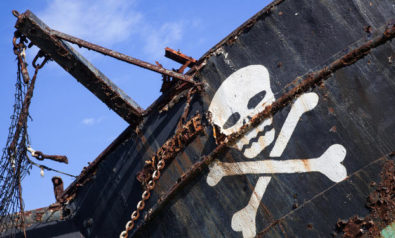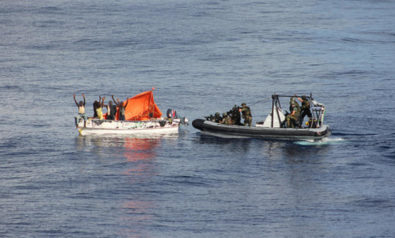Synergizing resources and technology from private and public stakeholders, can produce more effective and cost efficient counter-maritime piracy measures.
In light of sequestration, analysts project that countering maritime piracy will take a back seat to the Asia rebalancing and other more existential US foreign policy issues. Unfortunately, this rationing of focus has the potential to undermine and reverse a recent downward trend in maritime piracy incidents, particularly along the Somali coast. However, with piracy still costing the world economy $7 to $12 billion a year, fiscal challenges should ideally spur innovative efficiency, rather than obstructive neglect.
Further, even with current triumphs, commercial entities continue to lament threat information gaps. Contemporary counter-piracy measures include increased patrols, privatizing countermeasures, and attempted amelioration of piracy breeding socio-economic conditions under protracted, difficult and costly social initiatives. Experts posit that the first two of these countermeasures can account for the majority of recent counter-piracy success. Spurred by shrinking defense budgets, a new, more efficient solution framework, leveraging increased public-private integration, could provide an even more improved return on investment for all stakeholders.
There exists both a gap in information and cooperation for both naval forces and commercial vessels. An industry expert recently noted: “There is a great opportunity for the maritime industry to collaborate on threat reporting and risk assessments, because the industry shares a common adversary.” Thus, any additional solution must combine information sharing and cooperation while being fiscally viable.
An Alternative Approach
I propose a paradigm for a mutually-beneficial government-industry partnership. Here, both parties synergize comparative advantages — the navies provide power, technology, intelligence and resources, while the private companies provide capital. The capital and cooperation would thus enable the thrust of this relationship: efficient utilization of available naval power and more cognizant private vessel operations by way of standardized operations and communication; distributed intelligence and deployment of ISR (Intelligence, Surveillance and Reconnaissance) technologies all linked by an integrated control and monitoring system. In this framework, private shipping companies will buy into a regulatory system and invest in government fielding and development of intelligence collection systems needed to track pirates and their prey, while standardizing their anti-piracy procedures and cooperation. As a result, naval powers will be able to maximize security and trade in the sea-lanes at a lower cost. In return, private firms would benefit from added protection and intelligence, insurance companies will face smaller capital expenses and payouts, and all parties will enjoy increased stability and security.
Essentially, the system surpasses the sum of its parts — technology, communication, command, control and improved policies — to become a holistic synergy. The operational end of this initiative would be a more efficient utilization of kinetic and rescue resources working with compliant, and informed commercial vessels due to cooperative policies, better intelligence and a reduced fog of war. This improved situational awareness and operations would flow from technologies, analysis, and doctrine that provide red/blue force tracking, improved distress alerting, intelligence dissemination and closer relationships between government and the shipping industry. By monitoring the general environment, the location of commercial ships, “bad guys” (red force), and friendly naval vessels (blue force) and the trends therein, less resources are required to respond and patrol the same patch of water that has private vessels operating with improved awareness of the threat environment. Moreover, this system would truncate response time for rescue resources while increasing predictive alarms of suspicious vessels. In exchange, industry with a financial interest in protecting its personnel, assets, and customers, will subsidize these additional intelligence and surveillance initiatives while adopting recommended policies and procedures to facilitate cooperations and rescue ops.
A critical piece of this system is standard doctrines and best practices that improve cooperation, integration into the ISR system and self-sufficiency. In the US, standards and policies for disaster, fire preparedness, and preplanning are imposed on or suggested to communities and commercial sites by various government entities. This regulation saves lives and facilitates response efforts.
Similarly, the International Maritime Organization releases best practices for maritime piracy preparedness, reporting and prevention. For the proposed new anti-piracy measures, these standards should be both expanded and perhaps even mandated for vessels that would fall under protection of the naval systems in hazardous areas. Emphasis should continue on standardized rescue procedures, operational cooperation, distress signaling, infrastructure resiliency, and tactical/evasive training for commercial crews, along with standard terminology and communication. In concert, the IMO would expand training to include operation of new intelligence and rescue technologies. Similar to US Department of Homeland Security training for first responders, online videos and classes would be rolled out to proliferate and highlight critical teaching points for high-risk vessels. In sum, current education and standards would be enforced and expanded so commercial vessels become more compliant, self-sufficient and increasingly integrated with naval rescue ops.
The technical facet of the framework includes adding and integrating surveillance resources, identify friend-or-foe trackers and naval vessels into a sensor-fused command and control nerve center, housing industry and naval professionals in touch with friendly and neutral vessels. A layered approach to surveillance provides the greatest geographic coverage with minimal resources. At the macro level, wide-area surveillance resources would survey vast areas of water with piracy risk. These theatre based cues, in turn, drive acquisition and monitoring by more focused manned and unmanned systems on particular areas and entities of interest — in contrast to mass deployments of more narrowly focused resources. In order to generally assess the battle space and water currents, the highest area coverage, provided by satellite synthetic aperture radar and multi-spectral imagery, would be augmented by surveillance blimps for persistent surveillance and global hawk type drones with wide-area sensors. The next layer would include smaller resources that can get closer to targets, such as predators, fire scout helicopter drones and autonomous boats, operating from navy vessels. In addition to this imagery intelligence (IMINT), legitimate commercial and fishing vessels would be mandated to register and receive identity friend-or-foe beacons with GPS trackers.
All data streams would be encrypted and fused providing a private-public command and control center with a comprehensive view of the maritime domain battle space. At the culmination of this long line of data, risk could be assessed by identifying a confluence of threat through signature analysis, the presence of commercial boats as recognized by IFF beacons, and the environmental conditions that can facilitate attacks. As a result, resources can be efficiently allocated and prepositioned, private vessels can be rerouted, and confirmed pirate vessels can be intercepted or boarded early. In the event pirates engage private vessels, IFF distress beacons can easily guide in rescue personnel. The final product would allow more protection with fewer maritime assets expanding far beyond current limited intelligence products, such as the Piracy Performance Survey (PPS).
Effective and Cost Efficient
It might be noted that the preceding prescription touches on some already deployed technologies and resources. I mean to lay out premliminary principles and rudimentary macro level systems integration with the assumption that details, such as use of specific systems, can be worked out in the implementation. However, it is worth pointing out that many of these existing systems are disjointed, and flawed. An example is a recent security issue with the currently deployed Automatic Identification System (AIS), which tracks and transmits commercial vessel locations. Location of vessels in the Gulf of Aden were inadvertently made publically available, increasing piracy risk. With such technologies regulated and integrated into the broader proposed framework, data streams can be controlled in their fusion, dissemination and encryption so that intelligence is readily available to lawful consumers only.
Although not inexpensive, these technologies and resources are cost-effective compared to maintaining, deploying, and operating large naval fleets with comparable coverage. This is particularly true insofar as many of these ISR systems are already developed and in service elsewhere. Further, with piracy still costing billions of dollars annually, including high insurance premiums and large ransoms to secure release of crew and cargo, buying into this system could be cost efficient for private firms — contingent on working out the right level of protection in terms of an optimal cost/benefit ratio. In turn, this framework leases the front end acquisition and continual maintenance costs of these new, largely unmanned assets for naval “police” powers. Additionally, the US Navy, as the likely primary operator of these ISR systems, would have the benefit of new beta testing grounds for the kind of tightly integrated and networked sea systems and operations that will be critical to 21st Century sea dominance. For the maritime community, undermining the need for controversial private mercenary security, ameliorates the international concerns over the militarization of the seas.
In conclusion, an intelligence, operational and capital partnership between public and private industry stakeholders to deploy integrated ISR, sensor fusion analysis and policy cooperation, emerges as a logical evolution of piracy countermeasures, especially in the wake of shrinking defense budgets. With both sides investing their cooperation and comparative advantages in the new integrated framework, everyone benefits from the resulting improved security apparatus where resources are allocated, distributed, and operated surgically and efficiently. Plus, fiscal constraints aside, smarter operations with cheaper, more agile systems simply represents a logical evolution in policing against a truly asymmetric foe operating inexpensive skiffs. Integrated into a wide spectrum of anti-piracy measures, this new paradigm will hopefully not merely maintain, but actually increase the counter piracy triumphs of late.
*[Note: This article was updated on May 24, 2013.]
The views expressed in this article are the author's own and do not necessarily reflect Fair Observer’s editorial policy.
Image: Copyright © Shutterstock. All Rights Reserved
Support Fair Observer
We rely on your support for our independence, diversity and quality.
For more than 10 years, Fair Observer has been free, fair and independent. No billionaire owns us, no advertisers control us. We are a reader-supported nonprofit. Unlike many other publications, we keep our content free for readers regardless of where they live or whether they can afford to pay. We have no paywalls and no ads.
In the post-truth era of fake news, echo chambers and filter bubbles, we publish a plurality of perspectives from around the world. Anyone can publish with us, but everyone goes through a rigorous editorial process. So, you get fact-checked, well-reasoned content instead of noise.
We publish 2,500+ voices from 90+ countries. We also conduct education and training programs
on subjects ranging from digital media and journalism to writing and critical thinking. This
doesn’t come cheap. Servers, editors, trainers and web developers cost
money.
Please consider supporting us on a regular basis as a recurring donor or a
sustaining member.
Will you support FO’s journalism?
We rely on your support for our independence, diversity and quality.









Comment